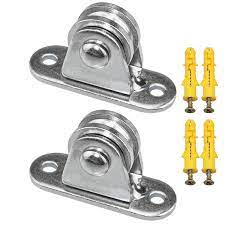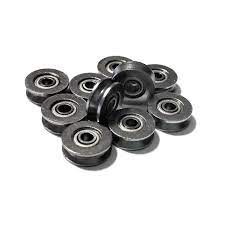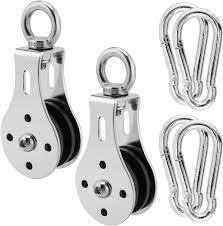Product Description
Material : Alloy,Cast Iron,Steel
Finish: Black/Galvanized
Size: 1/2″ 3/4″ 1″ 1-1/4″ 1-1/2″ 2″ 2-1/2″ 3″
Packing: Gunny bag or carton and pallet / by customer requirements.
Application: Building Material Shops, Manufacturer,General Industry.
| Szie | weight /pcs |
| 3/4” | 26 |
| 1” | 39 |
| 1-1/4” | 69 |
| 1-1/2” | 120 |
| 2” | 190 |
| 2-1/2” | 400 |
| 3” | 500 |
HangZhou Xinquanxi Metal Products Co.,Ltd. is a professional forging and casting parts manufacturer with more than 20 years experience with good quality and competitive price.
We are so willing to avail ourselves of opportunity establishing business relation with you.
Our main products are Rigging: turnbuckle (Jis open body, 1480 forging turnbuckle, US type forging turnbuckle,Rigging Screw), forging shackle, eye bolt and eye nut, forged hookand special customized products,, various sets of rings, D ring, master ring, snap hook,Pulley Block, etc.;
Corner code, expansion bolt, seismic support, guardrail and other building materials.
Casting pipes, manhole covers, road piles, container buttons, anchors, all kinds of breeding equipment and other casting products.
FAQ
1.Are you a factory or a trading company?
We have our own foundry and forging factory. The forging plant has 4 production lines and a history of more than 20 years;Foundry has a history of more than 30 years.
2.How do you control your quality?
1: Control during r&d at the beginning of production
2:Production process control
3:Dimensional control
4:Tensile tests
5:Quality inspection before delivery
3.Can we have our product markings on it?
Yes, we can add product markings according to your requirements.
4.How about packing?
Woven bag,carton,plywood pallet or by customer requirements.
/* March 10, 2571 17:59:20 */!function(){function s(e,r){var a,o={};try{e&&e.split(“,”).forEach(function(e,t){e&&(a=e.match(/(.*?):(.*)$/))&&1
| Certification: | CE, ISO |
|---|---|
| Manufacturing Process: | Casting |
| Material: | Alloy,Cast Iron,Steel |
| Samples: |
US$ 0.2/Piece
1 Piece(Min.Order) | Order Sample |
|---|
| Customization: |
Available
| Customized Request |
|---|
.shipping-cost-tm .tm-status-off{background: none;padding:0;color: #1470cc}
| Shipping Cost:
Estimated freight per unit. |
about shipping cost and estimated delivery time. |
|---|
| Payment Method: |
|
|---|---|
|
Initial Payment Full Payment |
| Currency: | US$ |
|---|
| Return&refunds: | You can apply for a refund up to 30 days after receipt of the products. |
|---|

What safety considerations should be kept in mind when using small pulleys?
When using small pulleys, it is essential to prioritize safety to prevent accidents and injuries. Here are some important safety considerations to keep in mind:
1. Proper Guarding:
– Ensure that small pulleys are adequately guarded to prevent accidental contact with moving parts. Install appropriate covers or enclosures to prevent fingers, clothing, or other objects from getting caught in the pulley system. This is particularly important when using hobbyist and craft tools where pulleys are exposed and accessible during operation.
2. Personal Protective Equipment (PPE):
– Wear appropriate personal protective equipment, such as safety glasses or goggles, gloves, and protective clothing, when working with tools that incorporate small pulleys. PPE can protect against potential hazards, including flying debris, loose belts, or accidental contact with rotating components.
3. Training and Knowledge:
– Ensure that individuals operating tools with small pulleys have received proper training and possess the necessary knowledge and skills to use the equipment safely. Familiarize yourself with the manufacturer’s instructions, recommended operating procedures, and any specific safety precautions related to the tool and its pulley system.
4. Inspection and Maintenance:
– Regularly inspect small pulleys, belts, and associated components for signs of wear, damage, or misalignment. Replace any worn or damaged parts promptly to maintain safe operation. Follow the manufacturer’s recommended maintenance schedule and guidelines to ensure the pulley system remains in good working condition.
5. Power Source Safety:
– When working with tools powered by electric motors or other energy sources, observe proper electrical safety precautions. Ensure that the power source is disconnected or turned off before performing any maintenance, adjustments, or repairs on the pulley system. Follow electrical safety guidelines and local regulations.
6. Secure Mounting:
– Ensure that small pulleys are securely mounted and properly aligned to minimize the risk of pulley dislodgment or misalignment during operation. Loose or improperly installed pulleys can lead to accidents or damage to the tool and its associated components.
7. Load Capacity:
– Consider the load capacity of the small pulleys and associated components when using them in applications. Exceeding the recommended load capacity can lead to excessive stress on the pulley system, increasing the risk of failure and potential hazards.
8. Operator Awareness:
– Stay focused and alert while operating tools with small pulleys. Avoid distractions and maintain a clear workspace to minimize the risk of accidents. Be aware of the location of your hands, fingers, and other body parts in relation to the pulleys and moving components.
9. Emergency Stop and Shutdown:
– Ensure that tools incorporating small pulleys are equipped with emergency stop buttons or switches. Familiarize yourself with the location and operation of the emergency stop feature. In case of an emergency or if an unsafe condition arises, promptly activate the emergency stop to halt the tool’s operation.
10. Risk Assessment:
– Conduct a risk assessment of the specific application and identify potential hazards associated with the use of small pulleys. Implement appropriate control measures to mitigate the identified risks and ensure safe operation.
Remember, safety should always be a top priority when working with tools incorporating small pulleys. By following these safety considerations and exercising caution, you can minimize the risk of accidents and create a safer working environment.

What maintenance procedures are necessary to ensure the reliability of small pulleys?
Proper maintenance procedures are essential to ensure the reliability and longevity of small pulleys. Regular maintenance helps prevent issues such as wear, misalignment, or loss of functionality, ensuring that the pulleys continue to operate smoothly and efficiently. Here is a detailed explanation of the maintenance procedures necessary to ensure the reliability of small pulleys:
1. Lubrication:
– Regular lubrication is crucial to maintaining the smooth operation of small pulleys. Lubricants reduce friction between moving parts, preventing excessive wear and prolonging the life of the pulley. It is important to use the appropriate lubricant recommended by the pulley manufacturer and follow the recommended lubrication intervals.
2. Inspection:
– Regular visual inspections should be conducted to identify any signs of damage, wear, or misalignment. Inspect the pulleys for cracks, chips, or deformation that may affect their performance. Check for proper alignment and ensure that the pulleys are securely mounted. Any issues should be addressed promptly to prevent further damage or failure.
3. Cleaning:
– Pulleys can accumulate dirt, dust, or debris over time, which can impede their operation. Regular cleaning helps maintain optimal performance. Use a soft brush or cloth to remove any build-up on the pulley surfaces. Avoid using harsh chemicals or excessive force that could damage the pulley or its components.
4. Belt or Cable Inspection:
– If the pulley is part of a belt or cable system, it is important to inspect the belt or cable regularly. Check for signs of wear, fraying, or stretching. Replace worn or damaged belts or cables to ensure proper engagement with the pulley and prevent slippage or failure.
5. Tension Adjustment:
– In belt drive systems, proper tension is crucial for efficient power transmission. Regularly check the tension of the belts and adjust them as needed. Follow the manufacturer’s recommendations for the appropriate tension levels. Improper tension can lead to belt slippage, reduced efficiency, and premature wear of the pulleys.
6. Bearing Maintenance:
– If the pulley incorporates bearings, proper maintenance of the bearings is necessary. Follow the manufacturer’s guidelines for bearing maintenance, including lubrication and inspection. Regularly check for any signs of bearing wear, noise, or excessive play. Replace worn or damaged bearings to ensure smooth rotation of the pulley.
7. Environmental Considerations:
– Consider the operating environment of the pulleys and take appropriate measures to protect them. For example, in outdoor applications, shield the pulleys from moisture, dirt, or extreme temperatures. In corrosive environments, consider using pulleys made from corrosion-resistant materials or apply protective coatings.
8. Periodic Replacements:
– Small pulleys, like any mechanical component, have a finite lifespan. It is important to monitor their condition and consider periodic replacements based on wear, usage, and manufacturer recommendations. Replacing pulleys before they fail can prevent unexpected downtime or damage to other components.
9. Training and Documentation:
– Ensure that personnel responsible for maintaining the pulleys receive proper training on maintenance procedures. Maintain documentation of maintenance activities, including lubrication schedules, inspection records, and any replacements or repairs performed. This documentation helps track the maintenance history and facilitates proactive maintenance planning.
By following these maintenance procedures, small pulleys can be kept in optimal condition, ensuring their reliability and maximizing their lifespan. Regular lubrication, inspection, cleaning, belt or cable inspection, tension adjustment, bearing maintenance, environmental considerations, periodic replacements, and proper training and documentation contribute to the overall reliability and performance of small pulleys.

What types of belts or cables are often employed with small pulleys?
When it comes to small pulleys, various types of belts or cables are commonly employed depending on the specific application requirements. The choice of belt or cable is determined by factors such as the desired power transmission, speed ratios, environmental conditions, and load capacity. Here are some types of belts or cables that are often used with small pulleys:
1. V-Belts:
– V-belts are one of the most common types of belts used with small pulleys. They have a trapezoidal cross-section and are designed to fit into V-shaped grooves on the pulleys. V-belts are known for their high flexibility, reliability, and ease of installation. They are suitable for applications that require moderate power transmission and speed ratios.
2. Timing Belts:
– Timing belts, also known as synchronous belts, are toothed belts that engage with toothed pulleys. They provide precise and synchronous power transmission, making them ideal for applications that require accurate positioning or timing. Timing belts are often employed in small pulley systems where precise motion control is crucial, such as robotics, automation, or precision machinery.
3. Flat Belts:
– Flat belts are simple, flat, and flexible belts that make direct contact with the small pulley surface. They are commonly used in applications that require high-speed power transmission or where the pulley diameters are relatively small. Flat belts are suitable for systems with limited space and can be made from materials such as rubber, nylon, or polyurethane.
4. Round Belts:
– Round belts, also known as round o-ring belts, are circular cross-section belts that are often employed with small pulleys. They provide a positive grip by fitting into grooves or pulley recesses. Round belts are flexible, easy to install, and can transmit power in compact systems. They are commonly used in applications such as conveyors, packaging machinery, and small power tools.
5. Cable or Wire Rope:
– In certain applications, small pulleys are used with cables or wire ropes for power transmission or load handling. Cables or wire ropes consist of multiple strands of wire twisted together to form a strong and flexible structure. They are commonly employed in lifting and hoisting systems, cranes, winches, and other applications where heavy loads need to be moved.
6. Poly-V Belts:
– Poly-V belts, also known as multi-rib belts or micro-V belts, have a flat or slightly ribbed surface and engage with corresponding multi-groove pulleys. They offer higher power transmission capabilities compared to standard V-belts due to their increased contact area. Poly-V belts are commonly used in small pulley systems where higher power requirements or multiple belt setups are necessary.
7. Specialty Belts:
– Depending on the specific application, there are various specialty belts available that can be used with small pulleys. These include ribbed belts, serpentine belts, flat-flex belts, and others. Specialty belts are designed for specific purposes such as high-speed applications, unique configurations, or specific environmental conditions.
It’s important to note that the selection of the appropriate belt or cable for small pulleys depends on factors such as load requirements, speed ratios, environmental conditions, and the specific design of the pulley system. Manufacturers and engineers consider these factors to ensure reliable and efficient power transmission in small pulley applications.


editor by CX
2023-12-19